Society and SailOn symbols as specific social values and ships as catalysts of social units This contribution is not intended to deny that there are functional properties and advantages with the appearance of the sail. It could in fact be undertitled `From function to symbol.' Instead it is supposed to serve as one of a number of possible explanations of an obvious ship archaeological problem. Why was the sail as an innovation accepted so late and so hesitantly by the North Germanic peoples? The second intriguing problem is the fact that it appears that the mast step and the Nordic sailing arrangement indicate that the Nordic sail rather was the result of an internal development in the north than an innovation directly from e.g. the Frisians. This leads to the idea that the sail was designed to mark or to solve an internal problem in the north. This problem is not only of a functional character. My explanation is going to be social or societal. However the first question to be addressed is the representativity of our archaeological sources. Were the North Germanic peoples actually late and hesitant? I mean they were, and the first part of this argumentation is dedicated to that issue. On the introduction of the sail in the northIt is rather surprising that the problem of rowing versus sailing has produced so few actual attempts of explanation. The period in question, the Merovingian Iron Age in Europe and in Sweden called the Vendel period, has been overshadowed because of the greater attractions of the preceding and highly dramatic Migration Age or the subsequent Viking period. It is thus an implicit homage to the glorious material of ancient Denmark that the latest comprehensive work of ship archaeology can be dedicated only to the period before the Viking Age (Rieck/Crumlin Pedersen 1988). The problem is unaccounted for also in the exposition of the rich material of Norway (Christensen 1966). As to Sweden, which only presents finds of rowing ships from the period of interest, there is no sign of preoccupation with the problem. However, it seems more or less unconsciously to be implicit in the numerous efforts to put imaginary masts and sails into the Kvalsund boat (of Norway) or the Sutton Hoo ship (of England), possibly even the Nydam ship (of Denmark).
The actual finds – irrespective of their representativity – imply the following situation. The square sail was known and used in the Mediterranean Sea several thousand years BC. The fore-and-aft lateen sail appeared in earnest during the first centuries AD (e g Casson 1971). Curiously enough, sails in general were from many points of view less well suited to this area than to the North Sea or the Baltic, if one is to judge from the long periods of calm in the Mediterranean. Already during the Gallic wars c 50 BC, Caesar met indigenous Venetic sailing ships in the North Atlantic. Within the parts of the Roman empire bordering the Atlantic sailing ships were probably more or less dominant for far-distant transports, such as the crossings of the Channel. It is thus clear that that the square sail as such must have been known early by the Germans. This reasonable statement is corroborated by the authentic carving of a Roman sailing ship with a runic inscription found in the river Weser (Bremen/ Bremerhaven) (Fig 1, Göttlicher 1989). And yet, the Anglo-Saxons still adhered to the rowing technique for the Channel passages at least in the 6th century, which was pointed out as a curiosity by Procopius, for that matter in a rather nebulous context (Prokopios VIII: 20ff; 1978 p 876ff). We have no intrinsic reason to doubt this statement since the material evidence at hand does not contradict it. The well-known lines of Tacitus Germania concerning the Suiones (linguistically more or less the Swedes) and their rowing ships, whose stems could easily be transformed into sterns, and Plinius, who mentions log boats with a crew of 30, both writing in the 1st century AD, point to a long tradition back to the time of paddling (cf Hirte 1989: 129). The earliest instance in Europe of rowed ships (push-oar-rowed? cf Ellmers 1978:1) on the Dürrnberg gold model of Austria is dated to the 5th century BC. The Nordic rock carvings seem to show paddled ships almost without exception, even though they are covering a time span from the Bronze Age far into the Iron Age. But Einar Østmo in Norway has recently pointed out two-prowed ship carvings from the Iron Age apparently with rowers (Østmo 1992). The first certain instance of rowing boats in the North is the rowlocks of the Halsnøy find of Norway, which is dated by cal 14C to AD 335 (dating according to Myhre 1980; Westerdahl 1987: 16). The practice of rowing may be a little earlier. A recent Norwegian bog find of a rowlock is dated between 30 BC and AD 250 (Ekroll 1988). The notion of an altogether too slow acceptance of new (if not independently invented) techniques among the North Germanic peoples seems premature. The Sutton Hoo ship of the first half of the 7th century can not be interpreted as a sailing ship (Bruce-Mitford 1975). The immediate impression is that of a royal rowing barge, somewhat like the much later Oseberg ship, although in the latter case to a certain degree adapted to sailing. As to the two Kvalsund boats of Norway, little more than half a century later (Myhre 1980), no clear proof exists to indicate arrangements for sailing. But the T-formed keel, a necessary prerequisite for advanced sailing, is certainly on its way (cf Shetelig/Johannessen 1929). The fact that depicted sailing ships appear only during the later part of the Merovingian period seems strange anyway. How is this to be explained? There is a possibility is that this is an illusion. The finds may not be representative. The grave finds expose special ships for special occasions, like rowing in state, or maybe even only for the funeral itself (most ships are, however, worn in actual use). The depictions may not be reflecting other than religious or related symbols, possibly reaching back to late Roman times. If it is so it seems remarkable that both some barges/ warships and cargo ships (Oseberg, Äskekärr etc) have got rather bad or undeveloped installations for sailing. In fact the full acceptance of the sail may be later than the Gotlandic picture stones. But this kind of reasoning presupposes the fact that there is no perceptible difference between war ships and cargo ships during the earlier parts of the Iron Age, before the Viking Age proper. Neither the supposed societal picture nor the postulated or reasonable amount of trade exclude such a view. The results of ship archaeology support it rather. The effort by Hirte (1989) – in opposition to earlier research – to consider the Vaaler moor and the Leck canoes from the Roman Iron Age of Germanic Schleswig from a 'civilian' point of view appears to overshoot the mark. The differentiation of ship types is very hazy, but it cannot be denied that a disparate element of great royal 'state' barges exists, as has been stated above (Sutton Hoo, Oseberg, and very possibly some smaller ones as well). Most ships were designed as multipurpose craft in early times.
The ships appear to pass through a period of simple and less full-blown sailing arrangements. They are well depicted on the Karlby stone, which is a miniature (Fig 2) from Djursland, W Jutland, Denmark, probably 8th century, although earlier datings have been proposed, even back to the Nydam ship, built c AD 310 sacrificed c AD 400, on the Sparlösa runic stone of Västergötland, Sweden, c AD 800 (Fig 3) and on the Gotlandic picture stones before AD 800 (redating: cf Varenius 1992, general aspects cf Andrén 1989, 1990, 1993). The mastbearing ships appear surprisingly late with the finds of Oseberg, dendrochronology dated AD 820 (dating according to oral communication by Niels Bonde, 1994), with a rather simple and weak maststep; Gokstad, Tune, Klåstad, Äskekärr, all 10th century; (Shetelig 1903, Nicolaysen 1882, Humbla 1934, Christensen 1976, 1979, oral communication by Niels Bonde 1994).
The latter appear indeed to be the result of a development on Nordic ground, not as a passive takeover from Western Europe (cf Lebecq 1983, on the possible Frisian influence). The adaption to a need for rapidly sailing, but still quite versatile, craft is conspicuous (the mast can easily be put down and set up again). With reference to the sailing capacity of the Scandinavian ships the unique hull form must be pointed out, particularly in the case of the meginhúfr, the sharply slanted strengthening strake, and the marked T-formed keel (cf the West European ship terms keel, kiel, of ships built according to Scandinavian traditions. At this time the first genuine cargo ships seem to appear, which are supposed to be at sea only under sail (Äskekärr, W Sweden, AD c 960, Klåstad, S Norway, 980 s, Niels Bonde oral communication, 1994). Moreover, it seems rather to be Western Europe that is influenced by strong Scandinavian traditions than the reverse, not only in the case of the rigging and the mast arrangement). Admittedly, there is still a problem of representativity in the lack of ship finds in Western Europe, but it may possibly be explained – at least partly – as a reflection of the relative importance of shipping in the North Sea in general. The Nordic ship terminology was accepted into English usage in some revealing aspects (e g thwart from ON thopta ), but also into French and other Romance languages (e g Sandahl 1951-58, Bloch/Wartburg 1950; e g French bitte (ON biti, beam), carlingue (ON kerling, keelson with mast step; very significant in this case!), varangue (ON vrang, rib). I would like to repeat how significant it is that the Nordic rig rather appears to be the result of an internal development. This has further implications in the sense that I would suggest an adaption to internal needs of the Nordic societies. This is, however, not only to be translated into the dichotomy between trading ships and warships. The contemporary terminology in scaldic verse also shows that the same term can be used for both categories (e g knarr; Malmros 1986: e g 103). But the lasting impression is that of progressive differentiation of ship types, even in the relevant ship terminology of the Viking Age The fact thus remains that the general picture is that of a gradual transition to sailing or to alternative sailing in rowing ships. The transition belongs to the 8th-10th centuries. I propose that the reason for this slow transition must be social or rather societal. I am now going to give the reasons for this revaluation of the evidence. Scandinavian ship shape society – a rowing societyThe transition to sailing ships is roughly contemporary with a couple of important changes in Scandinavian society. This is the immediate reason why I propose this scheme. I believe that the era of external appropriation of the Viking Age is contemporary with the actual state formation. It could even be a negative relationship: the chieftains and sea-kings at first flee the grasp of their kings by appropriating overseas. The gradual accumulation – and dispersal – of treasure in royal hands is a second necessary prerequisite. The Scandinavian kingdoms are a product of the Viking Age, or perhaps rather the reverse (cf Olsen 1988). Scandinavian kingship rests firmly on the sailing fleets of great chieftains and petty kingdoms. For several concurrent reasons there thus seems to be a connection between sail, fleets, state and Viking activity. But it has to be remembered that all these changes do not happen at once in the whole of the North. The reasonable starting point is Denmark. Both from the point of its agricultural resources, its manpower and its strategical position Denmark commands a dominant position in the North Sea and the Baltic. This also means that the fringes could possibly provide us with survivals – e g of earlier social organization – to be documented in an age when historical records are more widely disseminated. The Scandinavian Viking Age war ship is still primarily a rowing ship. It reflects traditions from an age when rowing was the only major means of ship propulsion. But it also points to the age of protostate organization. The Viking Age is still full of allusions to that age. Certainly there is no straight line from Tacitus Suiones ships from the first decades AD, but there is indeed such a line. The organization of men into ship units may have led to ship-formed houses already about AD 700 (cf Andrén 1993: 48, referring to Hvass 1988, Note 1). If we suppose that relicts and ancient ways are easier to find in the east and north of Denmark we may find some arguments in the important medieval territorial concept of Roden in Uppland, Sweden, literally meaning `the rowing districts', later called Roslagen (the Law of the Rod ; Calissendorff 1990, Stahre 1986). During the first part of the 11th century it is mentioned on runic stones as i Roð konungi, `in the Rod of the King' (Sö 11, Hovgården, Adelsö, Brate-Wessén 1924-26) and personalized in the concept of Håkans Rod, (Sö 16, Nibble, Ekerön; Brate-Wessén op cit) the personal name probably referring to the king himself. The term later appears in a feudalised territorial meaning. The concept of roðr, `rowing, rowing team', must have been so characteristic of the system, that it has not only been the basis of the Finnish name of Sweden, Fi Ruotsi (Est Rootsi), but also the Russian Rus (Greek rhos; although a somewhat disputed claim in this case). The significant element of roðr (`rowing district') may, anyway, very well have been obsolete during the last development of the place name or territorial concept. My proposal is to interpret the continuing importance of the rowing ship as an embodiment and symbol of the smaller units of society. The resistance to innovations, such as the sail, would have been social, and may even be characterized as social psychological. The lower levels of these fragmented Iron Age societies could possibly be expressed with the term lið (Kuhn 1956, Jakobsson 1992: 92 ff). A lið was not a territorial concept, but meant the following, the entourage (German: Gefolgschaft, a term often quoted) of a local chieftain. Already in these times the ship was very probably a microcosm in the sense reflected by the later levy (leding, leidang, ledung) organisation. Hå/hamna, literally meaning rowlock and fastening for the oar, in the ledung, of the Medieval province laws, was the smallest unit, a couple of farmsteads, sometimes a hamlet. Originally this concept therefore apparently represented the rowlock and bench (thwart) of a rowing crew for a chieftain's ship (cf Andrén 1993: 48, Westerdahl 1985a, 1985b, introductory part). The honour of being a bonde, a free man equipped with his own axe, sword and spear, may have been even less important than this permanent seat on a warship of one's master. This may have been the mark of distinction in a masculine warrior (or as in Andrén loc cit: male hierarchical) society, where only 'the best' are accepted into the team. In this case the system presupposes rowing men, not only in the ship, but also in the society as a whole, since this is only the maritime aspect of the following of a great man. The prestige effect of being rowed by one's own men was of a considerable social value to the king or chieftain. Royal barges have always been rowed, not only in the Pacific. Sails were used for other purposes. We may even find a remnant of this rowing society in two important and well-known concepts, viking and ledung (levy fleet organization). Víking is of course a well-known term but its etymology has never been satisfactorily interpreted. The word does not originally connote a `viking' as the 'title' of a marauder, but rather `a raid' or `a sea journey' (`going a-viking'). I would here propose that it may have had something to do with the vika, the ancient Nordic rowing measure, in the sense that it means the half of a rowing crew. The etymology of the vika is obvious, it must mean `a change of rowers', the general time span of a rowing team, before they are replaced by another. In the medieval itineraries the vika (ukæ søs, veckusjö) seems to be 8.3 kms at sea (Westerdahl 1990, referring to Poul Nørlund, Note 2). The second concept is that of lið (below) or the Nordic type of die germanische Gefolgschaft. My proposal is that the term ledung /leding /leidang (levy fleet, or the organization behind it) has a direct relationship to lið (as in the concept going `a-ledung', if I m permitted that parallel). The implication would be that the medieval levy fleets of the North posing as Crusaders in the east are the descendants of Viking age fleets, and that the medieval organization of the ledung type is derived from the lið. This hypothesis has probably many other interesting consequences on the study of social life during the Iron Age. The functional aspects also have to be reassessed in this context. I would argue that is not very far from function to symbol. Not to be seen – not even along the beachCompared to sailing ships rowing ships give undoubtedly military advantages to attackers (Fig 4, cf Note 3 on military considerations). The time to get reinforcements, for regrouping etc, can be measured quite accurately in rowing ships, whereas sailing ships are dependent on the strength and the direction of the wind. The rowing ships are also easier to keep together, and what might have mattered even more than this is the obvious advantage of not being seen, in principle not higher than the heads of the rowers. These are some of the functional reasons why rowing was still an important means of propulsion during the Viking Age. I suggest that the wings of the galley are not those of the sails, but those of the oars rising and sinking in consecutive, inexorable, overawing, motion (cf the title of Andersen/ Andersen 1989: Råsejlet – Dragens vinger = `The Square Sail – The Wings of the Dragon', Note 3). Fig. 4. Advantages of rowing over sailing ships. Drawing: Sune Villum-Nielsen. To be seen – even far out at seaAbove the aggressors would like not to be seen. In the case of sails the opposite is intended. Here is a strong wish displayed to be seen, to manifest or to demonstrate power. It may also be a way of showing legitimacy, because the intentions can be posed quite openly. For this purpose sails are very suitable, particularly in the form of a fleet with uniform character and uniform direction. Central power in the North could hardly have wanted a more effective form of demonstration. To command a sailing fleet is more to stake everything on one throw – which is infinitely more prestigious – to let the wind decide the rallying points. An advantageous outcome is only possible to one selected by the gods, and – as it were – one descending from the gods. Even the contrary case, a total catastrophe, would be the measure of a god-like fate, the immortal honour. This was said on Canute the Great:
It is possible that some of the depictions of stems in Nordic art point to the symbolic feeling of a particular sailing direction under royal supervision. I would suggest that this is most applicable on sailing, not rowing, ships. Thus, in a collective sense, the stems symbolize the whole fleet, and leadership in general. The most prestigious title on board a ship at the king's side was stafnbúi 'stem dweller'. Maybe that an isolated stem or stern could have a more complicated meaning. It certainly carries the potential of a pars-pro-toto. The deceased leader of the lið or the visi, styrir or styrimaðr (captain) of the lið or of the levy fleet district has still his seat at the stern in the boat graves (cf Andrén 1989: 310, 1991: 27). His skeleton may even wield the metal handle of his steering rudder (Nylén 1983: 29). Maybe it could even be said that the ability of the Viking mast arrangement rapidly to be shifted from sail to rowing and vice versa carries a certain significance in this connection, in fact a matter of social legitimacy and social morality. Such an ambivalence appears not only justified from a technical point of view. Pars-pro-toto?Another suitable metaphor for the ship, its leader and perhaps, even kingly power, depending on context, is the weather wane (veðrviti ; Blindheim 1983). It has been depicted ever since the Karlby and the Sparlösa ships (Figs 2,3) to the magnificent piece of Bergen harbour c 1250 (Ellmers 1972: 131, fig 104; Andersen/ Andersen 1987: 29ff). A dozen weather wanes from the Viking Age have been excavated or found in the Nordic countries, some of them miniatures in graves, clearly pointing to their symbolic importance. The context may perhaps reveal whether there is a further implication than the personal allusion to leadership. The magnificent runic stone of Spånga, Sweden (Sö 164, Brate-Wessén 1924-36) adorned with a ship and a cross at the place of the sail, appears as a monument signifying the definite pars pro toto that we have been discussing here:
The sail thus becomes a symbol of societal change in this period, even in grave ritual. The sailing ships of the Gotlandic picture stones reflect the becoming part of a fleet of a supreme Gefolgschaft, that of the gods – where even the chieftains are honoured to be chess pawns. I believe that it is in this context that we have to consider the intrinsic meaning of the details of Gotlandic sails (Fig 5). They are not unrealistic nor just the expression of a certain artistic convention. Their form is indeed remarkable to any man and should indeed be so. Probably such long rectangular sails will only make sense with a fair wind abaft the craft. To anyone who knew the performance of such sails the picture of them must have carried a certain significance. This is also the case with the intricate net pattern of hanfot lines under the sail, each being held by a crew hand. I would like to indicate that the significance of that picture is related to the following of a great man, be it chief, king or god. A possible iconographic interpretation is that this pattern refers to a very particular mythic ship, that of the god Freyr, called Skiðblaðnir, which 1) always had a fair wind and 2) was so intelligently constructed that it could be folded up and put into a purse (e g Hallberg 1978:42, Rieck, F/ Crumlin-Pedersen 1988: 152). Fig. 5. Gotlandic picture stone sail from Tjängvide, Askog parish. Sails as advertising pillarsThe effect of a sail – or a sailing fleet – above the horizon is certainly a symbolic value in itself. But the other possible uses have – according to my knowledge – never been discussed. My idea on this context concerns the representation of districts by symbols probably based on high level units of the lið types (in early medieval usage probably called härad/ hundare) on the Rod coast of Uppland/ Södermanland, Sweden. Starting with the depictions of a capercailzie cock (Swed (skog, hani) on three runic stones of Hanveden (`the capercailzie forest'; of Haninge, two parishes in medieval Christian times, Öster- and Västerhaninge) I have suggested in a popular article (Westerdahl 1991) that we may find other such animal symbols in other parts of the relevant districts. My examples were the place names of Lyhundra (the older name of Husby-Sjuhundra härad; the prefix ly- obviously from Swed. lo, lynx, Häverö, from haewer, buck (a parish; but also identical with a skeppslag, ship district) and Hökhuvud, also Uppland (`hawks head', a parish at the Olandsån river). In all of these and in a couple of other districts it was e g possible to pinpoint Snäck- place names, interpreted by me as the ledung harbours (the keeping-places for the ships during the winter). The general pre-heraldic tendency among the Germanic peoples to represent royal and aristocratic families as well as male warrior groups by different animals is well-attested (Höfler 1934, 1940, Steinnes 1938). Perhaps this goes for the pagan lið as well, and later for its descendants, the territorial units? The current symbols were certainly used well into Christian times. A counterpart could still be documented in historical times in Swedish animal nicknames for districts, villages or parishes (refs in Edlund 1984, 1985). Did the sails carry symbols?
The overriding sign of the cross appeared on the coins (Fig 6) from Carolingian times as a symbol of the power and protection of the emperor (Horstmann 1971). Possibly the cross carved on certain runic sails were genuine in a sense, especially on the Sparlösa stone in Sweden (fig 3) which may perhaps have indicated Swedish alliances with the emperor against Danish kings? A second suggestion is that the animal symbols referred to may have been used on the ships in a related way, preferably on the sails. The use of symbols on sails is not known in the north, however (Note 4). Olaus Magnus obviously refers to the ledung system ships in a passage in his Historia in 1555 (De forma et usu antiquarum nauium Septentrionalium, book 10:2, 1976: 181): "In olden times it was customary that every province, even those who did not reach the sea kept their ships with all their equipment in a secure harbour at the coast, often enough in covered sheds on the beach, such as I myself have been able to study at the coasts of Norway and also Sweden. If need be these ships were now provided in haste with necessary accessories, food and armed crews, as well as was possible during those times, whereupon they were put to sea and sent into war more of them or less according to the orders of the prince. They were by way of signs, colours and names ('signis, coloribus et nominibus/ distinctae') so easy to separate from each other, that they always, whenever a clash occurred with an enemy fleet, could without confusion be handled at the discretion of their commanders" (author's translation). Olaus' report on the ledung ships is probably based on his journey with concomitant interviews in Norrland, Sweden, in the years 1518-19 (Richter 1967, Westerdahl 1989). This could mean – in my version – that he, as a functionary of the church, could count on the support of an old transport system along the Norrland coast, with its ancestry precisely in the organization of the ledung. The last mention of an active ledung fleet in Sweden is dated to 1439 but in Finland (in many ways comparable to Norrland) as late as 1450 (Dahlström 1947). Memories might be blurred but they certainly existed in the beginnings of the 16th century. To distinguish between ships sails on the pattern mentioned by Olaus Magnus there are two main ways. Either the sails (paint, structure) were enough in themselves, or symbols were exposed on them (Note 5). The display of the precious materials and colours of sails is pointed out in several royal contexts. The sails of the Rus under king Oleg's command were supposed to be infinitely more precious than those of the Slovenes of his fleet (Nestors krønike 1983: 40) The Anglo-Saxon king Ethelstan used purple-coloured sails. At the entrance to Constantinople the Norwegian crusader king Sigurd Jorsalafar adorned his sails both fore and aft, so that no one in the crew would miss the point. It was said that Sigurd got a great reputation from this display (A-S Ingstad, in Christensen et al 1992). Fig. 7. Imaginary ledung sails of Uppland. Drawing: Bertil Kumlien (Westerdahl 1991b) The symbols, if there were any, would reasonably be put into the centre of the sail (Fig 7). The efficiency of such symbols is obvious. The display of participation and mobilization would convince doubters and stragglers, of whom there is abundant evidence in medieval Nordic ledung fleets. The pride of local lið symbols might have been decisive in a close combat, and even in a tactic replacement. Olaus Magnus also mentions the general effects to successful command at sea, not irrelevant to the training of a new aristocracy and of the King's hird. Even if this detailed suggestion is wrong the fact remains that Olaus points to eternal requirements in war fleets, the absence of which might lead to defeat and to the inglorious bickering on the irresponsibility of deserters. Symbols cannot only be many-sided in their appearance but also highly functional signs, in war as well as in peace. Function and symbolism are parallel factors. The sail is an obvious instance, although this brief and hypothetical exposition in no way exhausts the subject. NotesNOTE 1. The cognitive organization of domestic space could be expected to reflect `society (although not in a literal, direct way) in both a narrow and in all overall sense ( eg Hodder 1990). In this case Hodder's invented tripartite Indo-European categories domus, foris and agrios have got a younger brother, which we may – in the same vein – call maris ). NOTE 2. It has been shown by experiments on the Roskilde fiord (Crumlin Pedersen/ Vinner 1993) that in such a narrow rowing ship as Skuldelev 5, a possible ledung ship, only one side of the craft (in my version vika) might be rowing and the craft still keep the course for some time helped by the balance acts of the side rudder. NOTE 3. Already on board the rowing galleys of Caesar in the first century BC it was understood how to conquer the heavy Venetic sailing craft. Military considerations cannot have been irrelevant in any prehistoric situation. The efforts of king Alfred of Wessex around AD 900 show that such considerations were directly related to the construction of the ship. To conquer an enemy another type of craft than that of the adversaries may still be necessary: "They were almost twice as long as the others. Some had sixty oars, some more. They were both swifter and more stable, and also higher, than the others. They were built neither on the Frisian nor on the Danish pattern, but as it seemed to Alfred himself that they would be most useful " (The Anglo-Saxon Chronicle, AD 896; Keynes/ Lapidge 1983: 118; Garmonsway 1972:90). NOTE 4. The only well-known painted pictorial sails in recent times are those of the Italian small sea-side town of Cesenatico (Marzari 1988). I have even, excessively bravely, suggested that this Adriatic tradition may have something to do with the Germanic Lombards, amongst whom the continuous medieval use of animal symbols are well-known; e g the princes Cangrande of Verona (Höfler 1940). NOTE 5. The sails of the ships were made in breadths as wide as the looms. The stripes on the sails of the Bayeux tapestry will be enough as an example. (As in this case it was not unnatural in vernacular tradition to let an aristocratic person like Mathilde, the queen of William the Conqueror, stand for woolen work and for imagery of a related kind to the kind suggested in this hypothesis). Probably the breadths were painted in bright colours. The tent or sail of Oseberg was woollen (vað, vaðmál; Andersen et al 1989; Ingstad in Christensen et al 1992; and later possibly linen was used, perhaps nettle web, mull, /fine/muslin; silk in very exclusive contexts? cf The Nestor chronicle: Nestors Krønike 1983: 40). Hemp is possible from the evidence of some Norwegian finds. This would mean that the wool or hemp was made individually in many different breadths, probably at least officially by the wives of the lið warriors. In the same way the motley square sails of the so-called råbockar of lake Vättern in Sweden were made up to the end of the last century by the wives of the sailors of Harge, who owned the ships (Lemchen 1914). |
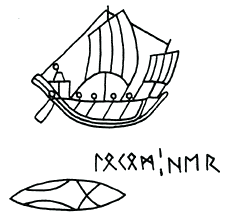
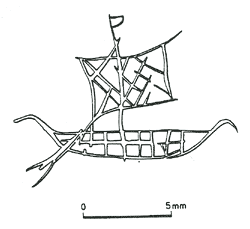
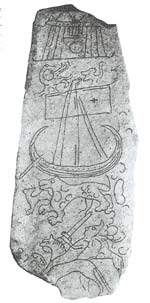

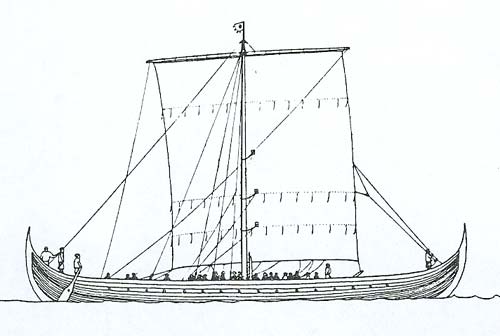
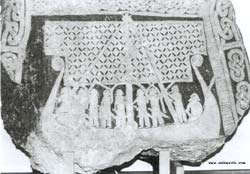
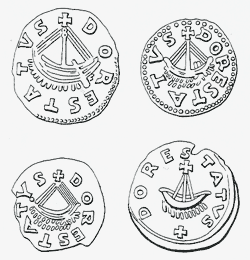
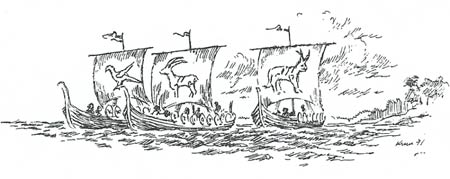
 Back to Nordic Underwater Archaeology
Back to Nordic Underwater Archaeology